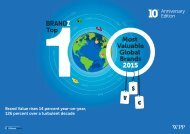L6inzM
L6inzM
L6inzM
Create successful ePaper yourself
Turn your PDF publications into a flip-book with our unique Google optimized e-Paper software.
GLOBAL SEMICONDUCTOR SURVEY 2014 | 5<br />
R&D spending consistent<br />
Since headcount growth in the semiconductor industry is often<br />
centered on research and development, it is no surprise that the<br />
outlook for research and development spending is consistent<br />
with the outlook for headcount growth. In this year’s survey,<br />
the number of executives expecting an increase in research<br />
and development expenses increased to 83 percent from 78<br />
percent in the prior year. However, more of these executives<br />
see growth in the research and development budgets in the 1–5<br />
percent range than at higher levels—a notable contrast from<br />
2013, when more executives were projecting increases of 6–10<br />
percent. Of course, it is not only headcount that drives research<br />
and development expenses as the cost of tooling for prototypes<br />
at advanced manufacturing processes continues to escalate. In<br />
fact, the rising cost of research and development expenses was<br />
identified in the survey as the biggest issue facing the industry<br />
and is contributing to the ongoing industry consolidation.<br />
Technology road map<br />
Nearly half of the executives say production of 450mm wafers will<br />
have a more significant impact on the industry than production<br />
at sub-20 nanometer technology nodes, but confidence in the<br />
pace of adoption has declined. In 2012 and 2013, nearly twothirds<br />
of executives expected 450mm commercial production to<br />
commence by the end of 2018. In 2014, more executives expect<br />
the transition to occur by the end of 2020 and significantly less<br />
expect the change to occur by the end of 2018. This perceived<br />
delay is consistent with the periodic updates provided by the<br />
major sponsors of this technology on the trajectory of adoption.<br />
The view that smaller geographies will have less impact on<br />
manufacturing cost is consistent with the responses to our new<br />
question about the viability of Moore’s Law. Only about 26 percent<br />
believe the benefits of Moore’s Law will continue to be realized for<br />
the foreseeable future, with the majority expecting the benefits to<br />
cease at some point on the road map past 22 nanometers.<br />
“<br />
We are pleased to see confidence in the<br />
industry consistently on the rise after an extended<br />
period of strong year-over-year growth. While the<br />
industry always faces myriad challenges —from<br />
shifts in the global economy to relentless pricing<br />
pressure — we see a number of disruptions in<br />
enterprise and consumer markets that are sure to<br />
provide many exciting growth opportunities in areas<br />
such as cloud, data analytics, autotech and the<br />
Internet of Things.<br />
As president of the GSA, I have had the pleasure<br />
to observe 20 years of amazing execution by this<br />
industry and extend my congratulations to KPMG on<br />
the publication of their 10th annual global survey!<br />
— Jodi Shelton, President,<br />
Global Semiconductor Alliance (GSA)<br />
”<br />
Image courtesy of revolv<br />
© 2015 KPMG LLP, a Delaware limited liability partnership and the U.S. member firm of the KPMG network of independent member firms<br />
affiliated with KPMG International Cooperative (“KPMG International”), a Swiss entity. All rights reserved. Printed in the U.S.A.




